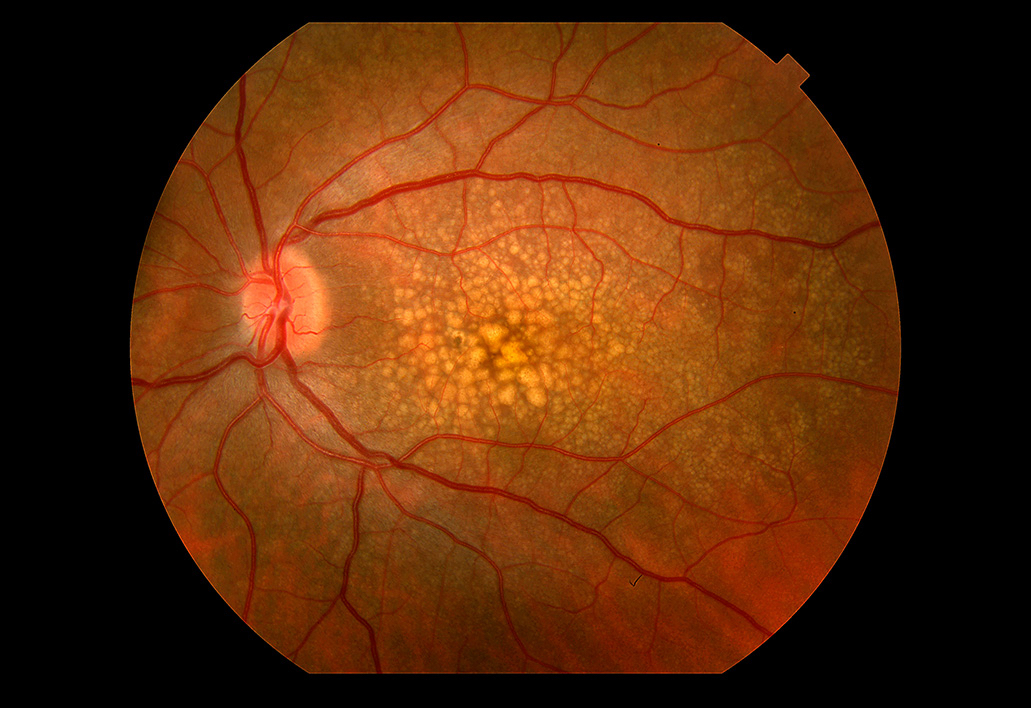
Drusen are yellow spots on the macula. They contain lipofuscin, which is degenerative material located below the center of the retina.
Macular degeneration, occurs when the central part of the retina, known as the macula, is damaged. When the center of the macula becomes damaged, vision loss can be severe. The macular area of the retina is responsible for detailed vision, such as reading and recognizing faces.
Macular degeneration is the leading cause of severe vision loss in people 60 years of age or older in the United States and throughout many parts of the world. If a person's macular degeneration can be detected in its earlier stages, steps can be taken to preserve vision. With appropriate treatment, vision loss can be prevented or slowed in some people with macular degeneration.
Atrophic or "Dry" Macular Degeneration is the most common form of macular degeneration, representing approximately 90% of all macular degeneration cases. However, dry macular degeneration accounts for only 10% of the severe vision loss associated with macular degeneration. Dry macular degeneration is characterized by development of yellow-white deposits underneath your retina, known as drusen, and can also be determined by deterioration of your retina.
 |
Drusen are yellow spots on the macula. They contain lipofuscin, which is degenerative material located below the center of the retina. |
The Age Related Eye Disease Studies were ground-breaking, involving macular degeneration vitamins sponsored by the National Eye Institute, one of the Federal government’s National Institutes of Health, and conducted at 11 major medical center research facilities around the country. Since that time, other studies, including the Lutein Antioxidant Supplementation Trial (LAST) have demonstrated visual improvement in patients taking specific high-dose supplements that include Lutein and Zeaxanthin. Specific macular degeneration vitamin ingredients and amounts were found to slow the progression of macular degeneration in those patients with intermediate or advanced disease. It is believed that macular degeneration vitamins contain specific anti-oxidants and Zinc that promote the continued health of the retina and tissues surrounding the retina.
Various formulas from major pharmaceutical manufacturers exist which are based upon the findings of AREDS 2, including Bausch & Lomb Preservision and VisiVite eye vitamins that are naturally-sourced.
In the absence of any macular degeneration, there is no research published that shows that taking vitamins can prevent macular degeneration. However, the AREDS study did show, if there was disease in only one eye, that taking proper vitamin supplements prevented or slowed the progress of the disease in the opposite eye.
Wet Macular Degeneration occurs when abnormal new blood vessels grow beneath the retina, leaking blood and fluid. Damage to the macula can occur rapidly, causing a noticeable loss of central vision. The vision loss from wet macular degeneration may be permanent, because abnormal blood vessels and scar tissue are actually replacing normal retina tissue. Once lost, these light-sensitive cells in your retina cannot be replaced.
An early symptom of wet macular degeneration is vision change, when straight lines appear wavy. For example, door frames may appear wavy instead of straight. Treatments are available that may slow and reduce vision loss associated with wet macular degeneration.
It is estimated that more than 2 million people in the United States currently have wet macular degeneration, with an increase of 200,000 new cases per year.
Who Gets Age-Related Macular Degeneration?
Macular degeneration is more common in older adults.
Macular degeneration may be hereditary, meaning it can be passed on from parents to children.